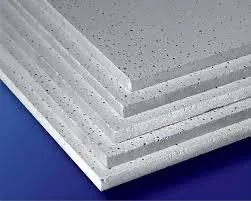Nov . 15, 2024 03:35 Back to list
gypsum board vs pvc ceiling
Gypsum Board vs. PVC Ceiling A Comparative Analysis
When it comes to selecting the right material for ceilings, two popular choices often come to mind gypsum board and PVC (polyvinyl chloride) ceilings. Both materials have unique properties, benefits, and drawbacks that cater to varying needs and preferences. This article aims to explore these two options in detail, helping homeowners and builders make informed decisions.
Gypsum Board An Overview
Gypsum board, commonly known as drywall, is made from a mineral called gypsum sandwiched between two sheets of thick paper. This material is renowned for its fire-resistant properties and excellent sound insulation capabilities. Gypsum board is typically used in residential and commercial spaces because of its versatility and ease of installation.
One of the standout features of gypsum board is its ability to provide a smooth, paintable surface. The aesthetic finish it offers allows for various design options, making it a favored choice among interior designers. Additionally, gypsum board is sustainable; it is often made from recycled materials and can be recycled itself, making it an environmentally friendly option.
PVC Ceiling An Overview
PVC ceilings are made from lightweight plastic panels that offer an entirely different set of characteristics. They are renowned for their water resistance, making them an ideal choice for areas prone to moisture, such as bathrooms and kitchens. PVC is also resistant to corrosion, which makes it a low-maintenance option that does not require frequent repainting or finishing.
These ceiling panels come in various designs, colors, and textures, offering unique aesthetic possibilities. The lightweight nature of PVC ceilings means they are easy to install, often requiring only basic tools and adhesives. Additionally, PVC ceilings do not sag over time, maintaining their structure and appearance.
gypsum board vs pvc ceiling

Cost Consideration
When comparing costs, gypsum board is often less expensive per square foot than PVC ceilings. However, the total cost can vary depending on the installation and finishing requirements. Gypsum board typically requires taping, mudding, and painting, which can add to the overall expenditure. In contrast, PVC ceilings can be installed quickly and easily without additional finishing, making them a more cost-effective solution in certain situations.
Durability and Maintenance
In terms of durability, PVC ceilings have the upper hand. They are resistant to moisture, insects, and mold, making them ideal for humid environments. Conversely, gypsum board can deteriorate when exposed to excessive moisture and may require repairs or replacements over time. Regarding maintenance, PVC ceilings require little care beyond regular cleaning, whereas gypsum board may need periodic repainting to maintain its aesthetic appeal.
Conclusion
Both gypsum board and PVC ceilings offer distinct advantages and disadvantages. Gypsum board is an excellent choice for those seeking a classic, paintable finish with sound insulation and fire-resistant properties. On the other hand, PVC ceilings provide an attractive, moisture-resistant alternative with low maintenance and easy installation.
Ultimately, the choice between gypsum board and PVC ceilings should be based on the specific needs of a project, taking into account factors such as location, budget, and desired aesthetic. By understanding the unique characteristics of each material, homeowners and builders can make informed decisions that best suit their requirements.
-
Durable Ceiling T Grid Systems | Easy InstallationNewsAug.29,2025
-
PVC Gypsum Ceiling: Durable, Laminated Tiles for Modern SpacesNewsAug.28,2025
-
Pvc Gypsum Ceiling Is DurableNewsAug.21,2025
-
Mineral Fiber Board Is DurableNewsAug.21,2025
-
Ceiling Tile Clip Reusable DesignNewsAug.21,2025
-
Ceiling T Grid Modular DesignNewsAug.21,2025







